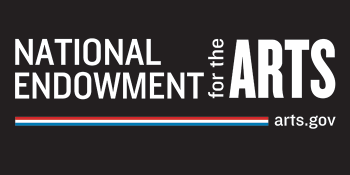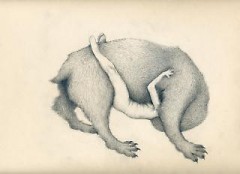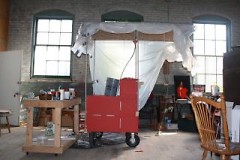Carrie Schoenborn, Scott Travis, and Patrick Hekman are all local contemporary artists, under the age of 30, exhibiting their work at UICA for ArtPrize 2010. Elizabeth Goddard, UICA’s Director of Education, had the chance to talk with them about their emergence, their creative intentions, and how current cultural events are revealed in their work.
Scott Travis lives and works in Grand Rapids. His ArtPrize entry is titled, Suspect. The work is roughly 4ft x 8ft and it depicts animal and human body systems, with various natural and representational forms created with graphite, charcoal, and ink.
Carrie Schoenborn is a student at Grand Valley State University, pursuing a BA in Art Education with an emphasis in painting. She recently returned from a year abroad in Florence, Italy where she participated in a collaborative project for the Festival of Creativity. Her ArtPrize entry, entitled This Is Not An Oil Spill, is a series of nine-inch drawings using waste oil and gesso on paper that will hang in the windows along Sheldon Blvd.
Patrick Hekman was born in Hong Kong in 1989 and is currently a student at Calvin College. He has exhibited in several group shows in Grand Rapids and his ArtPrize entry is his first exhibition experience at UICA. His ArtPrize entry, entitled A Perfect Human in His Imperfect Habitat, explores the question of whether or not human constructed habitats are suitable for people to be truly human in. Over the course of ArtPrize, Heckman will live without a permanent habitat and document his experience.
Creating artwork begins with an intention; what are your intentions as a visual artist? What do you want viewers to take away from their experience of engaging with your work?
Travis: My intentions lie somewhere in using mythology and symbolism to relate human identity to non-human life and our environment. The ability of a viewer to perceive and think about this relationship is important to me.
Schoenborn: I think in the broadest sense my work focuses on interactions: interactions with other people, with the world, or with objects. This Is Not an Oil Spill focuses specifically on an awareness of our interactions with products. Everyday we are surrounded by so many objects, that many of them become ubiquitous to the point that we don’t even think about where these objects come from or how they get to us. Ideally, someone would walk away from this work of art and think, “I wonder what my shirt is made of?” or “I wonder how much oil it takes to make the nail polish I am wearing?”
Hekman: I want the viewers to take away a question, an inspiration, or a hit in the face. I don’t want them to just take away a story, an image, or a thought. I want them to realize those stories, images, and thoughts are meant to be a tool for them so they can discover their own story, understand themselves, and inspire their own actions. I want them to take away the tool and the manual for that tool at the same time, through engaging with my art. I don’t want the experience with my art to become the last of its impact, but that the impact carries on.
Art is a reflection of the times in which it is created, what about our current culture does your art reflect?
Travis: I think that we live in a time of real uncertainty, and that this uncertainty is evident through the mass of apocalyptic/post-apocalyptic pop-culture that is out there right now, not to mention how terrifying turning on the radio for ten minutes can be. (Ironically, as I am responding to this question, I am listening to an album titled: "Sadly, the future is no longer what it was.") My work often portrays organisms which are both familiar and unidentifiable, and in a transitory state in relation to the human condition.
Schoenborn: With the recent oil spill in the Gulf and the even more recent spill in Kalamazoo, people are becoming more aware of the threats, environmental and otherwise, imposed by the oil industry. My work points to the innumerable ubiquitous oil-based products that saturate our lives and asks the viewer to question why the oil industry has become so expansive and why oil drilling is necessary in the first place.
Hekman: I hope my art reflects something deeper than our current culture. I hope my art reflects something of the deep struggles (inherent in being human) that time becomes irrelevant. And without time, culture does not exist.
If there were something you could change in the world today, what would it be?
Travis: There are many artists out there who are investing a lot of time and energy into building local systems for cultural exchange, and this is the case especially in Grand Rapids with certain driven individuals. They are working to change the world, starting small and working locally on things that are a huge benefit to local culture and economy. So these things that I would want to change are already changing.
Schoenborn: I think that greater awareness of personal and societal consumption would do a lot to change the world for the better. We consume so much in the world today. Not just food and products, but also images, sounds, and information. I think greater awareness will lead to more thoughtful and less wasteful consumption.
Hekman: I wish to change the ability we have to perceive and understand. I wish that we could feel and perceive as we did long ago when we were hunter-gatherers, when our senses and curiosity were so vast and sharp. I wish the world would once again be curious and alarmed.
Is there any advice you have for other emerging artists?
Travis: Make art for yourself.
Schoenborn: In my experience there are three main fears that prevent new artists from moving forward: fear of failure, fear of rejection, and fear of a lack of originality. Over time, I have come to realize that failure is just another opportunity to learn and grow. Rejection happens to everyone so at some point you just have to let go. You may get rejected, but at least you won’t be wondering what could have happened if you’d tried. And as far as a lack of originality goes, I’ll paraphrase Twyla Tharp and simply say everything’s been done so get over your self. I guess, simply put, my advice would be to just go for it and do your thing.
Hekman: I always ask people to be honest, in every way, to yourself and others. Especially with art making, as it so closely relates to the artist’s own internal conflicts and self-expression. Artists need to know who they are, and how they relate to others. It is only through great honesty that a human can achieve any degree of self-knowing. Without self-knowing and realization, one’s artwork is soulless and meaningless.
The Rapidian, a program of the 501(c)3 nonprofit Community Media Center, relies on the community’s support to help cover the cost of training reporters and publishing content.
We need your help.
If each of our readers and content creators who values this community platform help support its creation and maintenance, The Rapidian can continue to educate and facilitate a conversation around issues for years to come.
Please support The Rapidian and make a contribution today.



